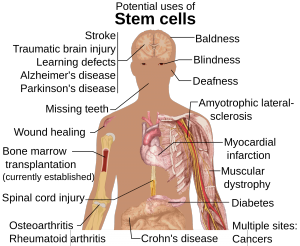Just a couple of weeks ago, we learnt that scientific breakthroughs d on’t occur as frequently as we may perceive. However, new progress in stem cell research may just have made it to the outliers. A recent experimental research has shown hopes of mobility in people after a stroke. The experiment injected stem cells into the brain in hopes of rejuvenating blood vessels and other cells. This in some ways will repair damaged parts of the brain and enable movement in stroke victims. Stem cells are cells which can break out and grow into numerous more cells including ones that are different from the origin. Stem cell injections have been used multiple times to help joint treatments and other diseases which require rebuilding of cells, tissue etc. However, not until recent times have scientists begun using these types of treatment in brains. A recent experiment conducted by a neurosurgeon at Stanford University showed improvement in the movements stroke patients. The injections worked well in rats, the stem cell dissolved and helped join brain cells and repaired blood vessels. These injections were later given to 18 participants, each receiving up to three amounts of stem cells. Depending on their conditions, each participant got injected with 2, 5 or 10 million cells. There are numerous types of stem cells, for the purposes of this experiment, Gary Steinberg made use of mesenchymal stem cells. These cells are special because they have the ability to branch out into other types of cells like bone cells, cartilage cells, muscle cells and fat cells. These cells were taken from bone marrows of healthy humans and put into the mobility controlling part of the brain. For additional aid, these strums were modified and included a gene type present in infants. The scientists expected that this gene will help with the development of the brain and improve problems of slurred speech in the patients. The ingredients to create this gene type was taken from aborted infants and showed certain levels of improvements in the patients. Seeing the detailed and risks of this experiment, there have been several debates on it’s ethicality. Hence, research like this one are not conducted often and when they are, they are usually held under highly controlled circumstances. However, the researchers believe that this breakthrough can lead to more time being spent on the topic and will further improve the practice.
on’t occur as frequently as we may perceive. However, new progress in stem cell research may just have made it to the outliers. A recent experimental research has shown hopes of mobility in people after a stroke. The experiment injected stem cells into the brain in hopes of rejuvenating blood vessels and other cells. This in some ways will repair damaged parts of the brain and enable movement in stroke victims. Stem cells are cells which can break out and grow into numerous more cells including ones that are different from the origin. Stem cell injections have been used multiple times to help joint treatments and other diseases which require rebuilding of cells, tissue etc. However, not until recent times have scientists begun using these types of treatment in brains. A recent experiment conducted by a neurosurgeon at Stanford University showed improvement in the movements stroke patients. The injections worked well in rats, the stem cell dissolved and helped join brain cells and repaired blood vessels. These injections were later given to 18 participants, each receiving up to three amounts of stem cells. Depending on their conditions, each participant got injected with 2, 5 or 10 million cells. There are numerous types of stem cells, for the purposes of this experiment, Gary Steinberg made use of mesenchymal stem cells. These cells are special because they have the ability to branch out into other types of cells like bone cells, cartilage cells, muscle cells and fat cells. These cells were taken from bone marrows of healthy humans and put into the mobility controlling part of the brain. For additional aid, these strums were modified and included a gene type present in infants. The scientists expected that this gene will help with the development of the brain and improve problems of slurred speech in the patients. The ingredients to create this gene type was taken from aborted infants and showed certain levels of improvements in the patients. Seeing the detailed and risks of this experiment, there have been several debates on it’s ethicality. Hence, research like this one are not conducted often and when they are, they are usually held under highly controlled circumstances. However, the researchers believe that this breakthrough can lead to more time being spent on the topic and will further improve the practice.
As for the results of the study, the researchers noticed that the victims responded positively to the experiment. One exceptional recovery was seen in the case of an elderly woman who increased mobility from just a thumb to her legs, arm and head. Of course not everyone showed such drastic improvements, however on average most patients saw some improvement in their mobility. Seeing that the experiment involved only 18 patients, it’s hard to conclude that this new form of treatment definitely works, but it has opened up a door to a new experiment which is looking to involve 156 new patients.
The image above shows only some of the potential deficiencies that can be cured by this treatment. A scientific breakthrough in this field would change many lives and can also further deepen our understanding of the human body.
Citations
-
@newscientist. “Stem Cell Brain Injections Let People Walk Again after Stroke.” New Scientist. N.p., 2 June 2016. Web. 21 Oct. 2016.
- “Stem Cell Basics I. | Stemcells.nih.gov.” U.S National Library of Medicine. U.S. National Library of Medicine, n.d. Web. 21 Oct. 2016.
- “Mesenchymal Stem Cell.” Wikipedia. Wikimedia Foundation, n.d. Web. 21 Oct. 2016.
